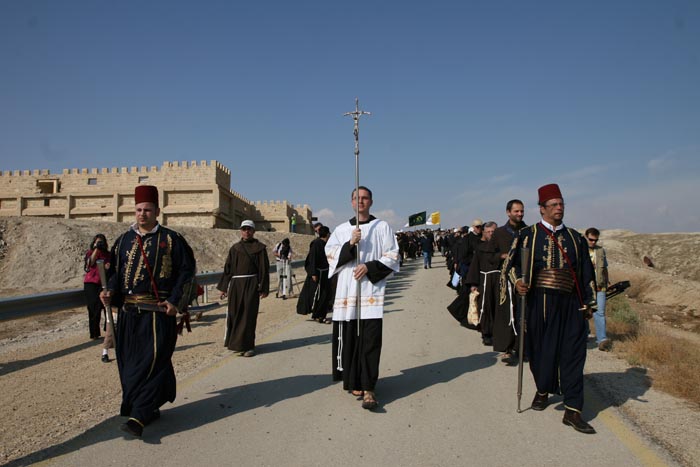
Some 450 people—parishioners from Jerusalem, Haifa and Nazareth, religious brothers and sisters from Jerusalem and pilgrims from abroad—participated in the Custody of the Holy Land’s annual pilgrimage to the banks of the Jordan River, where they were met by parishioners from Jericho and their pastor, Father Feras Hejazin ofm.
Under the hot sun of the Jordan Valley, Mass was celebrated by the Father Custos, Pierbattista Pizzaballa. The readings for the Baptism of Jesus were proclaimed in different languages and the Prayer of the Faithful was in over ten different languages, more than ever before. The crowd followed the ceremony fervently and everyone was able to renew their baptismal promises. At the conclusion of the Mass, the pastor of the Jerusalem parish, Father Ibrahim Faltas ofm, celebrated the baptism of a very young new parishioner. Then the pilgrims headed for the banks of the Jordan. On the other side of the river, which is five to eight meters wide at this site, another group of pilgrims shared this same act of faith. Watching over everyone were some twenty Israeli soldiers.
This pilgrimage, which takes place on the last Thursday of October every year, as attested as early as 1567 by Boniface of Raguse, a former Custos of the Holy Land, is exceptional. Since 1967, the site, on which the Custody of the Holy Land possesses land and a convent, has been a militarized border zone covered with minefields. From 1967 to 1985 the annual pilgrimages were interrupted for reasons of security. It was only after long negotiations that the Custody was again permitted access to the river’s banks. The old convent is still off limits.
The morning passed, therefore, under military surveillance, but the soldiers were intrigued enough by their detail to have brought their cameras to immortalize the procession, adding their own snapshots to the photos and videos of the twenty-odd journalists who covered the event. Texts from the sixteenth century indicate that the prayer at the Jordan River was followed by an ascent of Mount Nebo on the other side of the river, now in Jordanian territory; today, however, the busses set out for the Mount of Temptation after Mass. Since the fourth century, Christians have venerated it as the location of the Temptation of Christ, and on the side of the hill Greek Orthodox monks built a monastery as only they know how. Behind the stones and in the midst of arid desert, lies the splendor of Orthodox art, the icons rivaled only by the frescos.
Before entering this jewel “in the clefts of the rock” (Sg 2:14), the pilgrims had a time of prayer and listened to the Gospel of the Temptation. Then they entered the holy place, and venerated the rock of the mountain. Everyone returned home pleased with this day of encounter and prayer.
MAB
Under the hot sun of the Jordan Valley, Mass was celebrated by the Father Custos, Pierbattista Pizzaballa. The readings for the Baptism of Jesus were proclaimed in different languages and the Prayer of the Faithful was in over ten different languages, more than ever before. The crowd followed the ceremony fervently and everyone was able to renew their baptismal promises. At the conclusion of the Mass, the pastor of the Jerusalem parish, Father Ibrahim Faltas ofm, celebrated the baptism of a very young new parishioner. Then the pilgrims headed for the banks of the Jordan. On the other side of the river, which is five to eight meters wide at this site, another group of pilgrims shared this same act of faith. Watching over everyone were some twenty Israeli soldiers.
This pilgrimage, which takes place on the last Thursday of October every year, as attested as early as 1567 by Boniface of Raguse, a former Custos of the Holy Land, is exceptional. Since 1967, the site, on which the Custody of the Holy Land possesses land and a convent, has been a militarized border zone covered with minefields. From 1967 to 1985 the annual pilgrimages were interrupted for reasons of security. It was only after long negotiations that the Custody was again permitted access to the river’s banks. The old convent is still off limits.
The morning passed, therefore, under military surveillance, but the soldiers were intrigued enough by their detail to have brought their cameras to immortalize the procession, adding their own snapshots to the photos and videos of the twenty-odd journalists who covered the event. Texts from the sixteenth century indicate that the prayer at the Jordan River was followed by an ascent of Mount Nebo on the other side of the river, now in Jordanian territory; today, however, the busses set out for the Mount of Temptation after Mass. Since the fourth century, Christians have venerated it as the location of the Temptation of Christ, and on the side of the hill Greek Orthodox monks built a monastery as only they know how. Behind the stones and in the midst of arid desert, lies the splendor of Orthodox art, the icons rivaled only by the frescos.
Before entering this jewel “in the clefts of the rock” (Sg 2:14), the pilgrims had a time of prayer and listened to the Gospel of the Temptation. Then they entered the holy place, and venerated the rock of the mountain. Everyone returned home pleased with this day of encounter and prayer.
MAB

